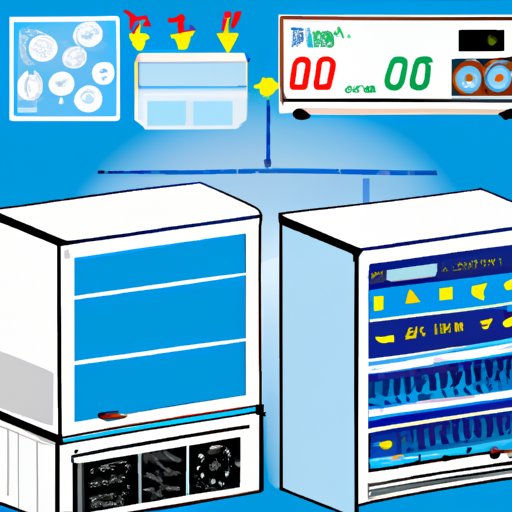Introduction
A refrigerator is a major appliance in most households, used to store food and drinks at a steady temperature. It usually consists of two compartments – the larger one being the fridge and the smaller being the freezer. The freezer is designed to keep food frozen at a lower temperature than the fridge.
If your refrigerator is working but the freezer is not freezing, this can be a frustrating problem. In this article, we will explore why your refrigerator may be working but its freezer is not freezing, and how you can diagnose and repair it.
Troubleshooting a Refrigerator with a Non-Freezing Freezer
The first step in troubleshooting a refrigerator with a non-freezing freezer is to check the temperature settings. If the temperature settings are too low, the freezer will not get cold enough to freeze food. You can adjust the temperature settings on the control panel, or consult the owner’s manual for instructions.
Next, check the evaporator fan. This fan circulates air throughout the freezer compartment and helps maintain a consistent temperature. If the fan is not working properly, the freezer may not stay cold enough to freeze food. Check the fan for any obstructions and make sure it is spinning properly.
Inspect the condenser coils. These coils help dissipate heat from the refrigerator and should be cleaned periodically. If the coils are clogged with dirt or dust, the refrigerator will not be able to cool effectively and the freezer may not freeze food.
Finally, check the defrost timer. This component regulates the defrost cycle and ensures the freezer does not become too cold. If the timer is malfunctioning, the freezer may not reach the desired temperature.
Causes of a Non-Freezing Freezer in Your Refrigerator
There are several possible causes of a non-freezing freezer in your refrigerator. One of the most common causes is a faulty temperature control. If the temperature setting is not adjusted properly, the freezer may not reach the desired temperature.
Another common cause is blocked vents or ducts. These components help circulate air throughout the freezer compartment, and if they are blocked, the freezer may not stay cold enough to freeze food. Clean the vents and ducts to ensure proper airflow.
Dirty condenser coils can also prevent the freezer from reaching the desired temperature. These coils help dissipate heat from the refrigerator and should be cleaned periodically. If the coils are clogged with dirt or dust, the refrigerator will not be able to cool effectively and the freezer may not freeze food.
A malfunctioning defrost timer can also cause a non-freezing freezer. This component regulates the defrost cycle and ensures the freezer does not become too cold. If the timer is malfunctioning, the freezer may not reach the desired temperature.
Finally, low refrigerant levels can cause a non-freezing freezer. Refrigerant helps regulate the temperature of the refrigerator, and if the levels are low, the freezer may not stay cold enough to freeze food.
How to Fix a Refrigerator that is Working but Not Freezing
To fix a refrigerator that is working but not freezing, you will need to adjust the temperature settings, unblock the vents and ducts, clean the condenser coils, replace the defrost timer, and check and refill the refrigerant levels.
Adjust the temperature settings on the control panel, or consult the owner’s manual for instructions. Unblock the vents and ducts to ensure proper airflow. Clean the condenser coils to remove any dirt or dust buildup. Replace the defrost timer if it is malfunctioning. Finally, check and refill the refrigerant levels if necessary.
Simple Steps to Diagnose and Repair a Refrigerator with a Non-Freezing Freezer
Follow these simple steps to diagnose and repair a refrigerator with a non-freezing freezer:
Step 1: Check the temperature settings. Adjust the temperature settings on the control panel, or consult the owner’s manual for instructions.
Step 2: Inspect the evaporator fan. Check the fan for any obstructions and make sure it is spinning properly.
Step 3: Clean the condenser coils. Remove any dirt or dust buildup from the coils.
Step 4: Replace the defrost timer. If the timer is malfunctioning, the freezer may not reach the desired temperature.
Step 5: Refill the refrigerant. Refill the refrigerant levels if necessary.
Understanding the Components of a Refrigerator and How to Fix a Non-Freezing Freezer
It is important to understand the components of a refrigerator and how they work together in order to diagnose and repair a non-freezing freezer. The temperature control regulates the temperature of the refrigerator, while the vents and ducts help circulate air throughout the freezer compartment. The condenser coils help dissipate heat from the refrigerator, and the defrost timer regulates the defrost cycle. Finally, the refrigerant helps regulate the temperature of the refrigerator.
Common Reasons for a Refrigerator’s Freezer Not Freezing and How to Fix It
There are several common reasons for a refrigerator’s freezer not freezing, including a faulty temperature control, blocked vents or ducts, dirty condenser coils, a malfunctioning defrost timer, and low refrigerant levels. To fix a refrigerator that is working but not freezing, you will need to adjust the temperature settings, unblock the vents and ducts, clean the condenser coils, replace the defrost timer, and check and refill the refrigerant levels.
Conclusion
Having a refrigerator that is working but not freezing can be quite a headache. Fortunately, there are several common causes and solutions for fixing a refrigerator with a non-freezing freezer. Understanding the components of a refrigerator and how they work together can help you diagnose and repair a non-freezing freezer quickly and efficiently.


